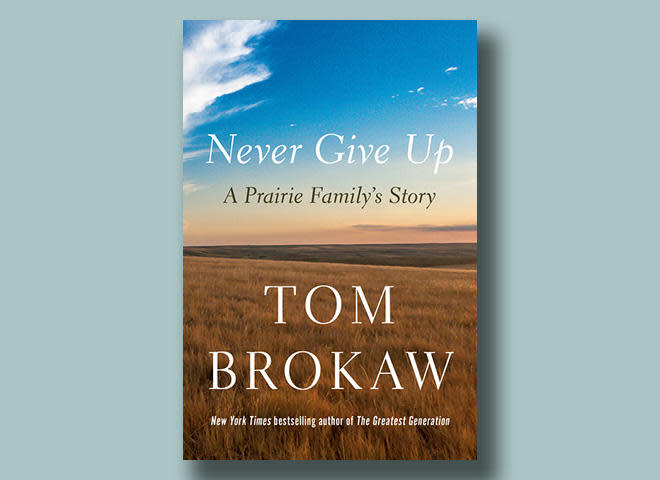Book excerpt: "Never Give Up: A Prairie Family's Story" by Tom Brokaw

- Oops!Something went wrong.Please try again later.
We may receive an affiliate commission from anything you buy from this article.
Veteran newsman Tom Brokaw's books include the New York Times bestselling chronicle of World War II, "The Greatest Generation"; "The Fall of Richard Nixon: A Reporter Remembers Watergate"; and the memoir "A Long Way From Home: Growing Up in the American Heartland in the Forties and Fifties."
In his latest book, "Never Give Up: A Prairie Family's Story" (Random House), Brokaw writes of his ancestors settling the American Midwest, and how the Midwesterners' can-do attitude helped define a nation.
Read the excerpt below, and don't miss Jane Pauley's interview with Tom Brokaw on "CBS Sunday Morning" June 25!
"Never Give Up: A Prairie Family's Story" by Tom Brokaw
Prefer to listen? Audible has a 30-day free trial available right now.
Bristol, South Dakota
In the late nineteenth century, in the Great Plains of Middle America, the American savanna, the land rush was on.
It was a vast swath of real estate that was low on water and rich in challenges—from brutal winter seasons to scorching summers. Until recently it had been the home of enormous herds of antelope and American bison, the magnificent beast prized for its rich pelts and thick cuts of red meat.
After the Civil War and during the great migration of immigrants from northern Europe and Scandinavia to America, that part of the United States was also prized for two irresistible qualities: Land was dirt cheap (or free), and there was lots of it. America's flourishing railroad industry saw fresh opportunity for new business, so it pushed into that harsh but promising prairie.
My great-grandfather, R.P. Brokaw, left his Upstate New York home after the Civil War and headed west seeking security as a farmer or innkeeper.
The Brokaws were Huguenots, enterprising Protestants who had fled France and taken up residence in Holland before coming to America, where many flourished in New York and New Jersey real estate, the arts, and civic affairs. But R.P. Brokaw took another route, not nearly as rewarding. R.P. went north, into the New York wilderness, where he opened a small market in the Finger Lakes region.
He was a quartermaster and clerk for the North in the Civil War, emerging with a modest pension to finance his trip to the new territories in the American West.
He rode the rails and farmed along the way until he reached what was to become the state of South Dakota. Founders of the Milwaukee Road railroad saw opportunity in the eagerness of the new immigrants to take advantage of land bargains. R.P. stopped in a new village of wooden shanties and primitive homes because it had a promising feature: a rail line north and south and one east and west.
A Milwaukee Road railroad developer had given these new villages British city names and this one was called Bristol. R.P. decided it needed overnight accommodations. He started with a tented commissary and then began constructing the first substantial building in town and called it The Brokaw House. R.P., his son William, and his daughter-in-law, Elizabeth, ran The Brokaw House as a hotel, boardinghouse, and center of civic activity.
By 1889, South Dakota, with statehood, began to attract more settlers, but it remained a frontier.
William would meet incoming Milwaukee Road trains as they arrived on that stretch of the prairie. He would greet the passengers with a pitch for Elizabeth's home cooking at the hotel, saying, "If you don't get enough to eat, it won't cost you a dime."
The Brokaw House was famous for its dining room, which featured lace tablecloths and an elaborate Sunday menu of oyster stew, roast turkey, duck, roast beef, lamb, tongue salad, mashed potatoes, suet pudding, apple, mince, custard and blueberry pies, ice cream, and assorted cakes, all prepared by Elizabeth in a kitchen with an enormous woodburning stove, while her ingredients were kept fresh by great blocks of ice packed in wood shavings in an icehouse.
Somewhere along the way, a Roman Catholic priest converted Elizabeth and she became a devout Catholic, rejecting the Huguenot connection. Nine of her children followed suit, and to this day my cousins, aunts, and uncles on that side of the family are devout Catholics.
In the fall of 1912, William and Elizabeth were expecting their tenth child. That was my father, and somehow the Catholic priest missed him in the conversion crusade.
That's where this Brokaw prairie saga really begins.
Excerpted from "Never Give Up" by Tom Brokaw. Copyright © 2023 by Tom Brokaw. All rights reserved. No part of this excerpt may be reproduced or reprinted without permission in writing from the publisher.
Get the book here:
"Never Give Up: A Prairie Family's Story" by Tom Brokaw
Buy locally from Bookshop.org
For more info:
"Never Give Up: A Prairie Family's Story" by Tom Brokaw (Random House), in Hardcover, Large Print, eBook and Audio formats
REPORTER’S NOTEBOOK: Margaret Brennan’s trip to China
Full interview: Cindy McCain, World Food Programme executive director

